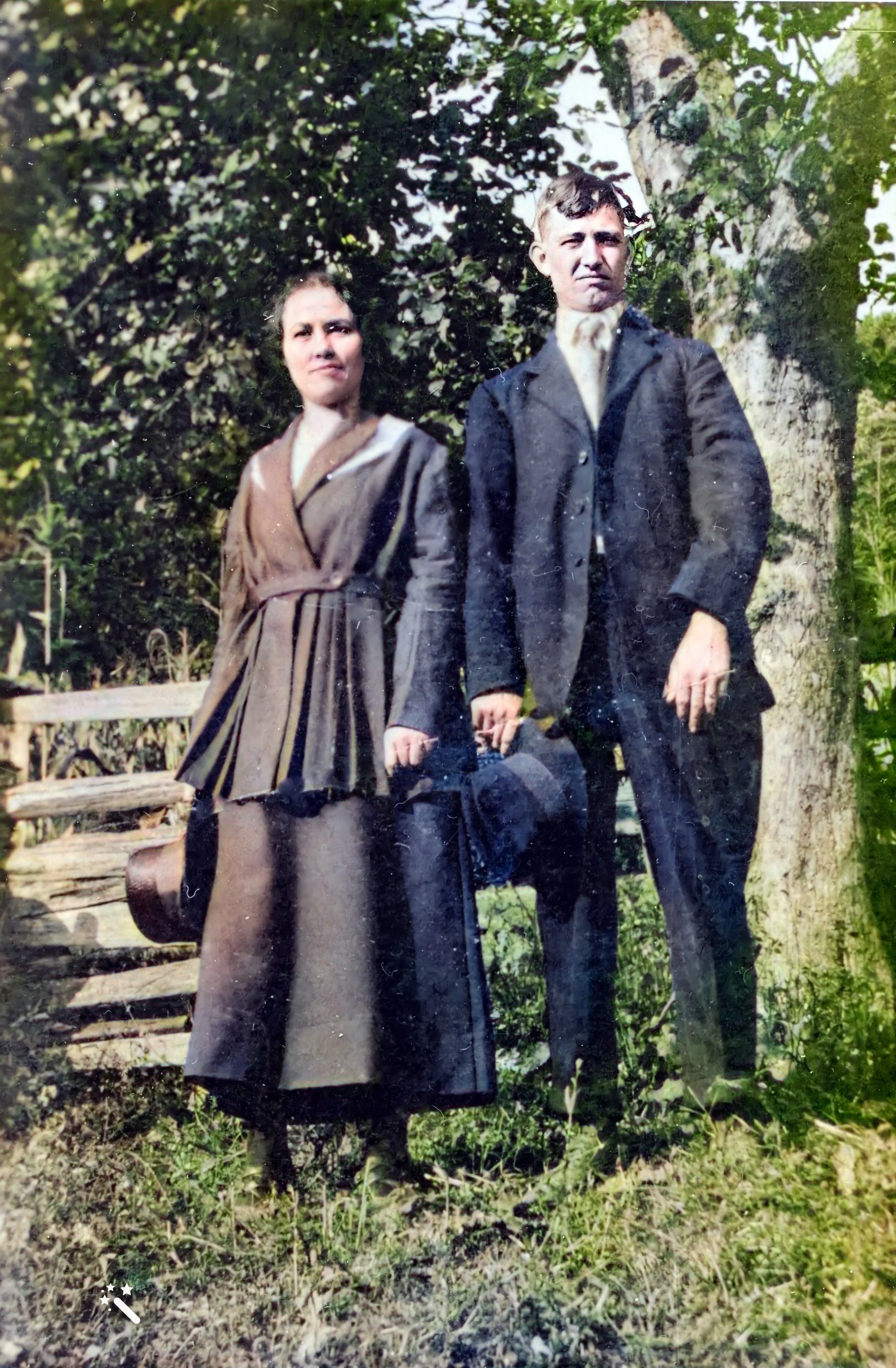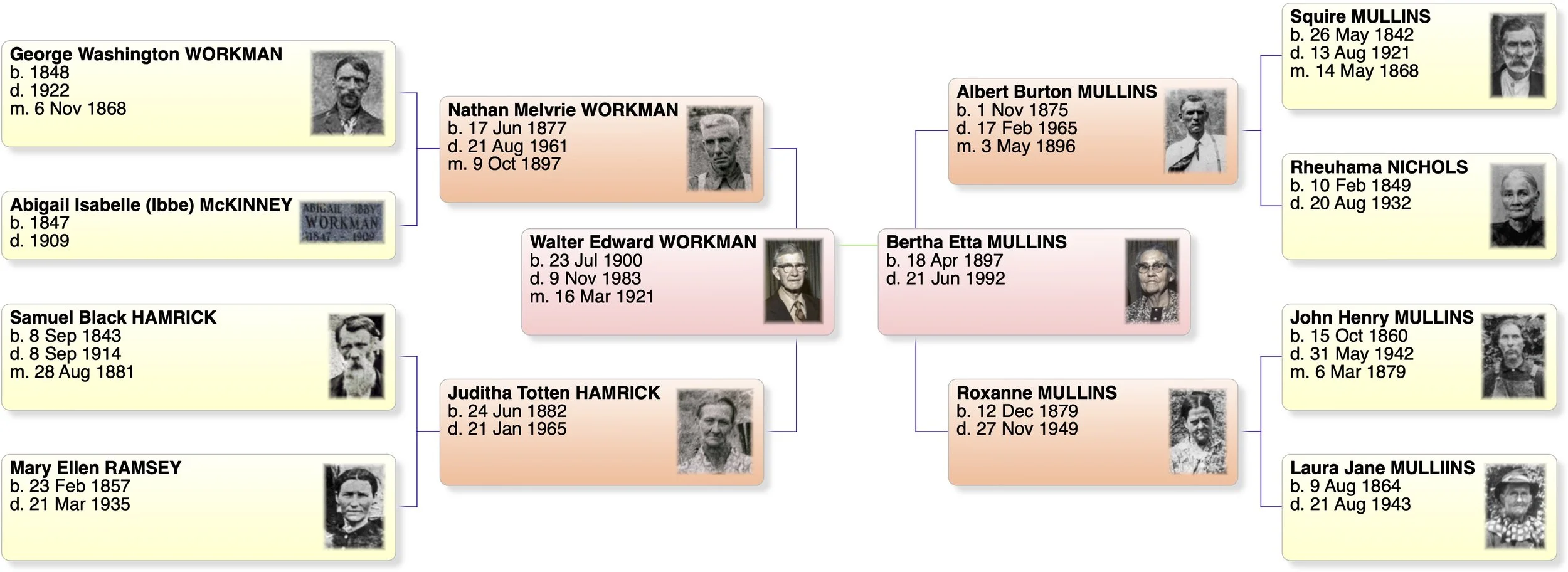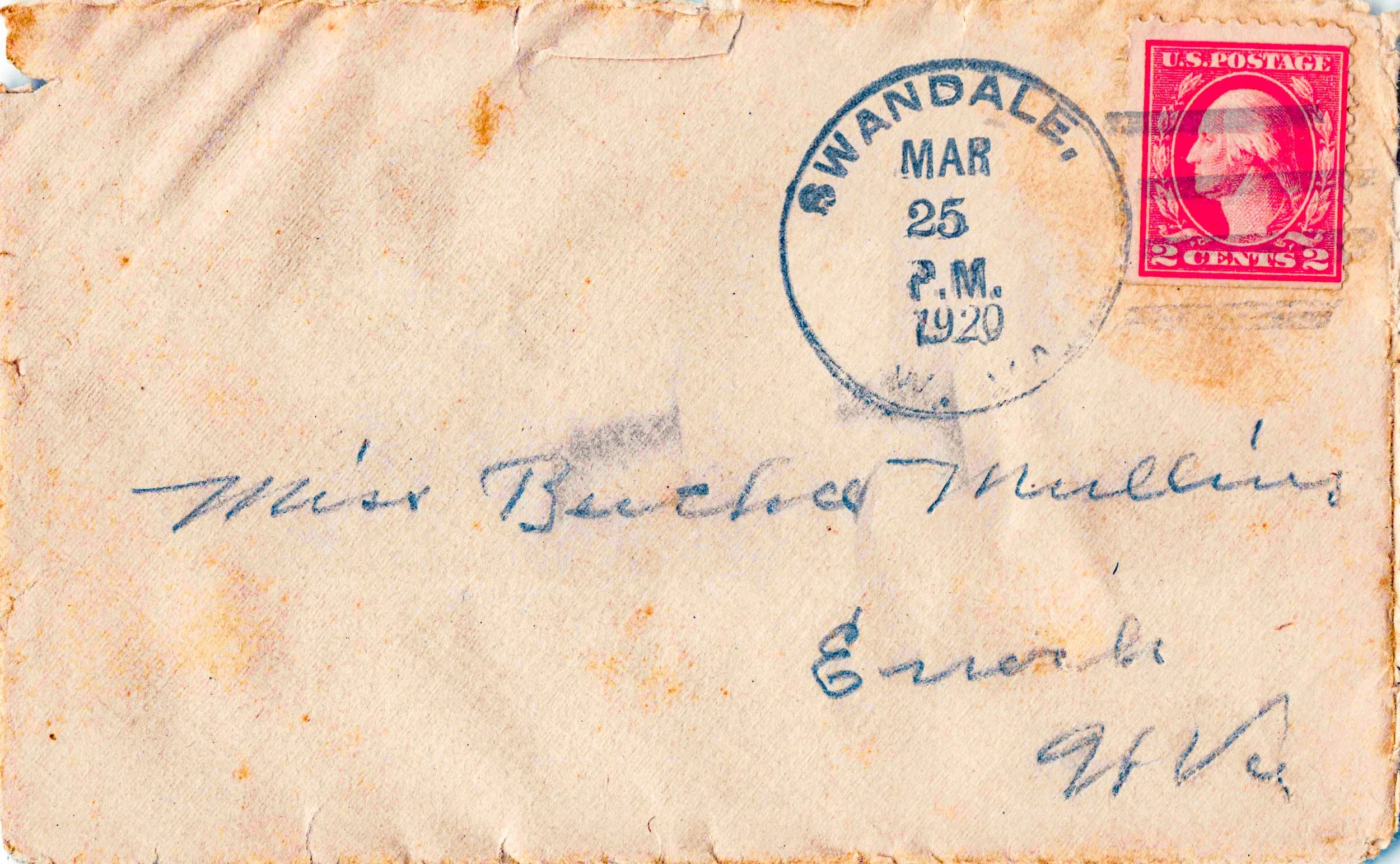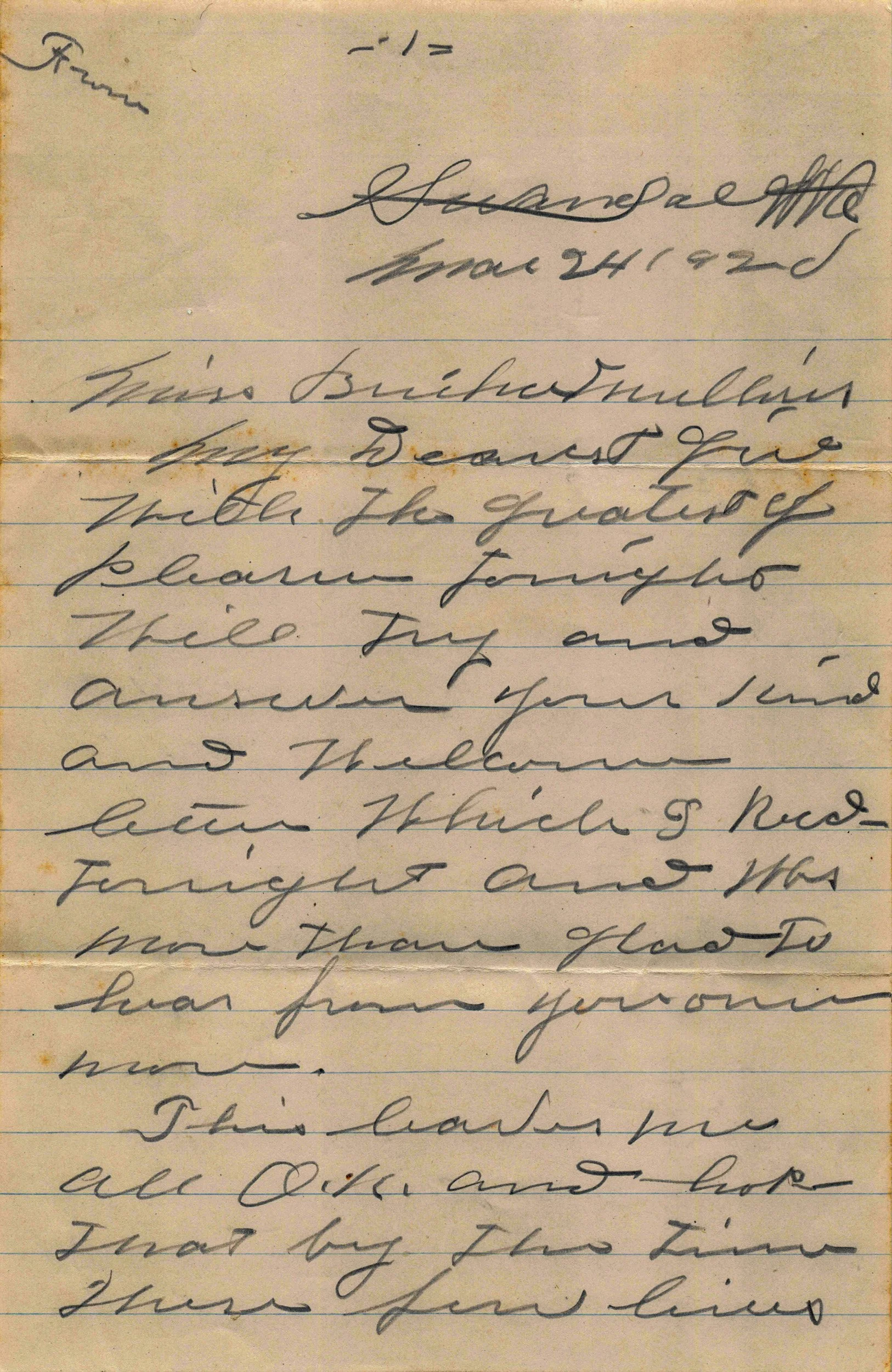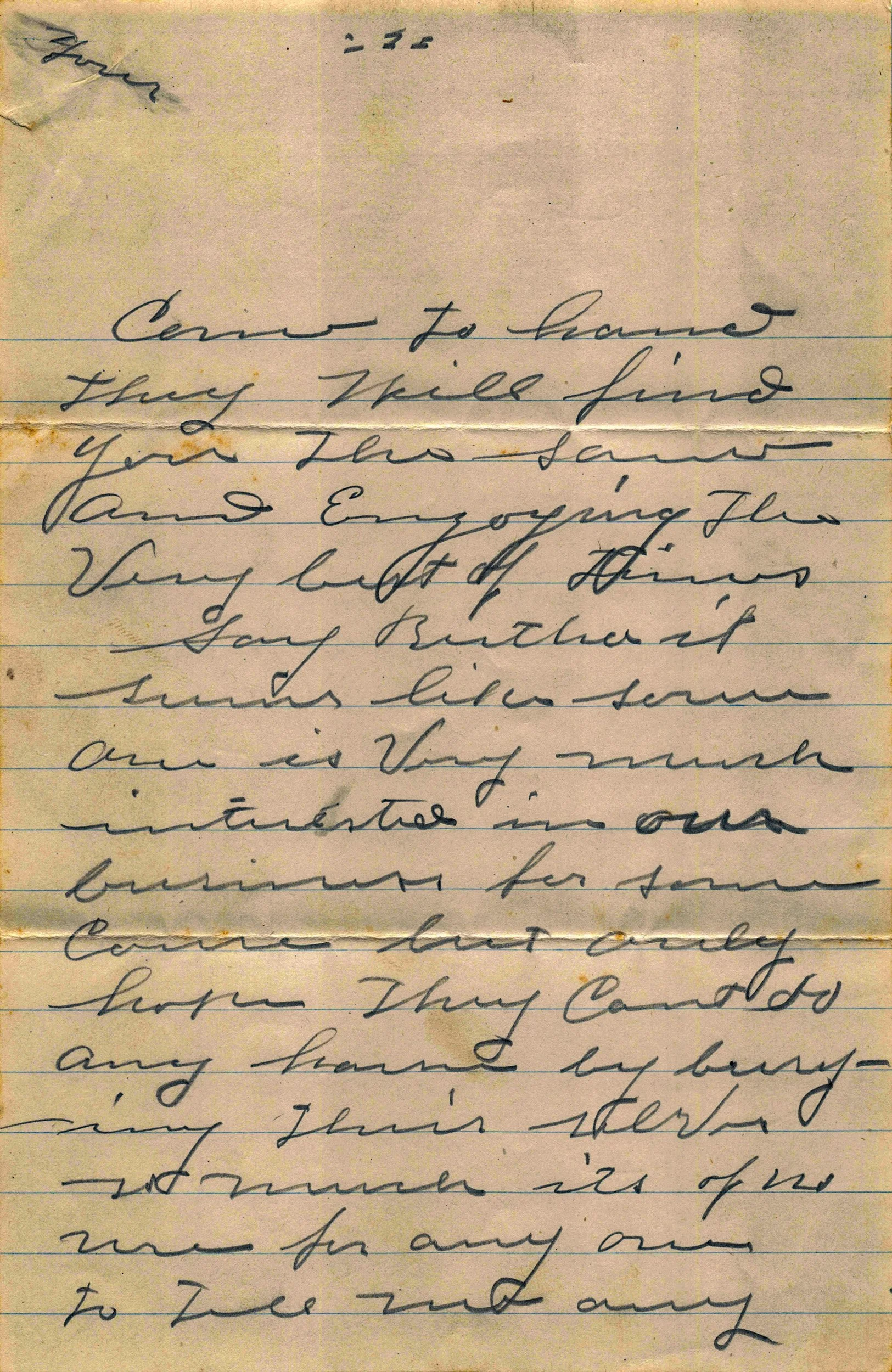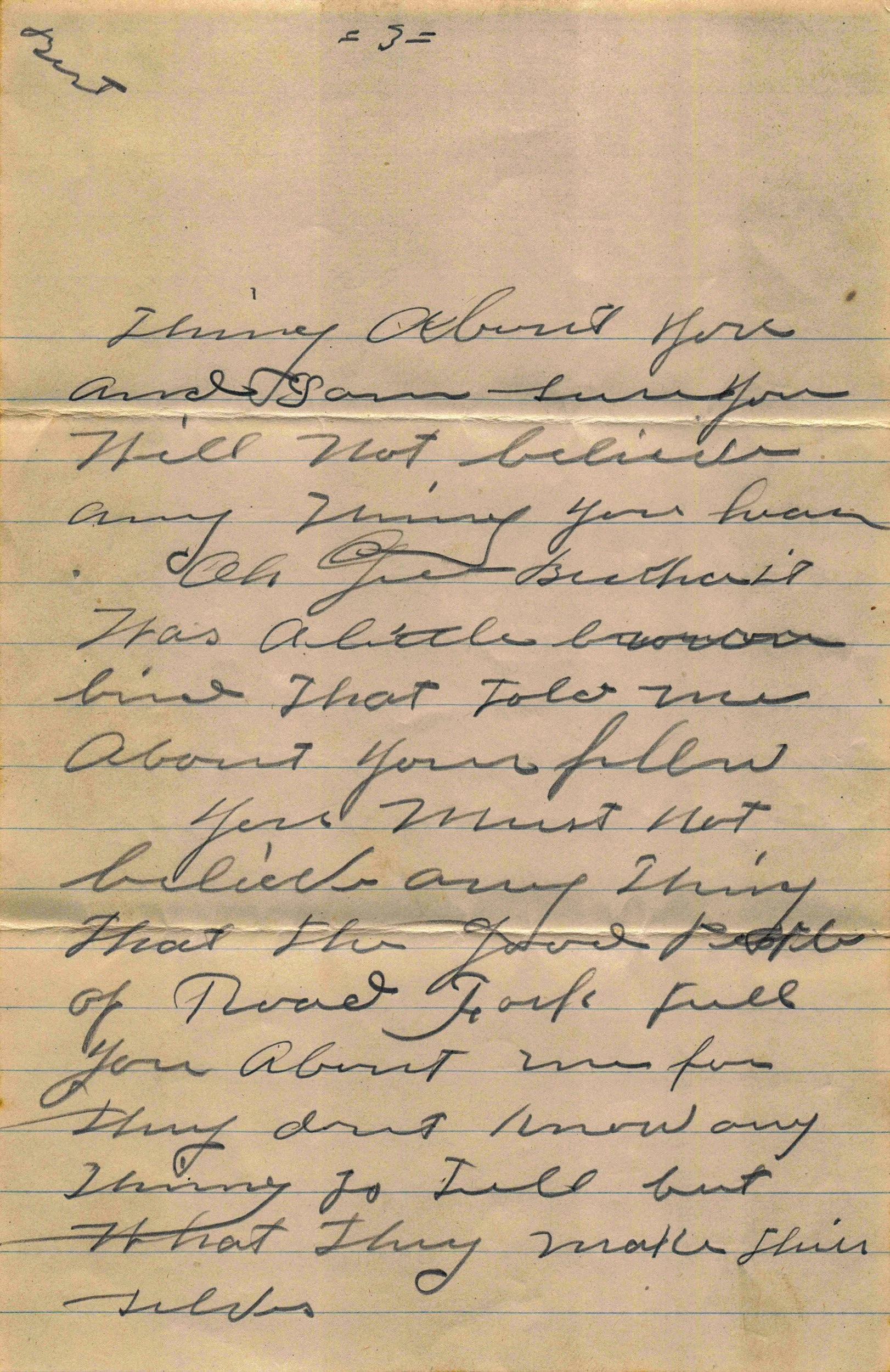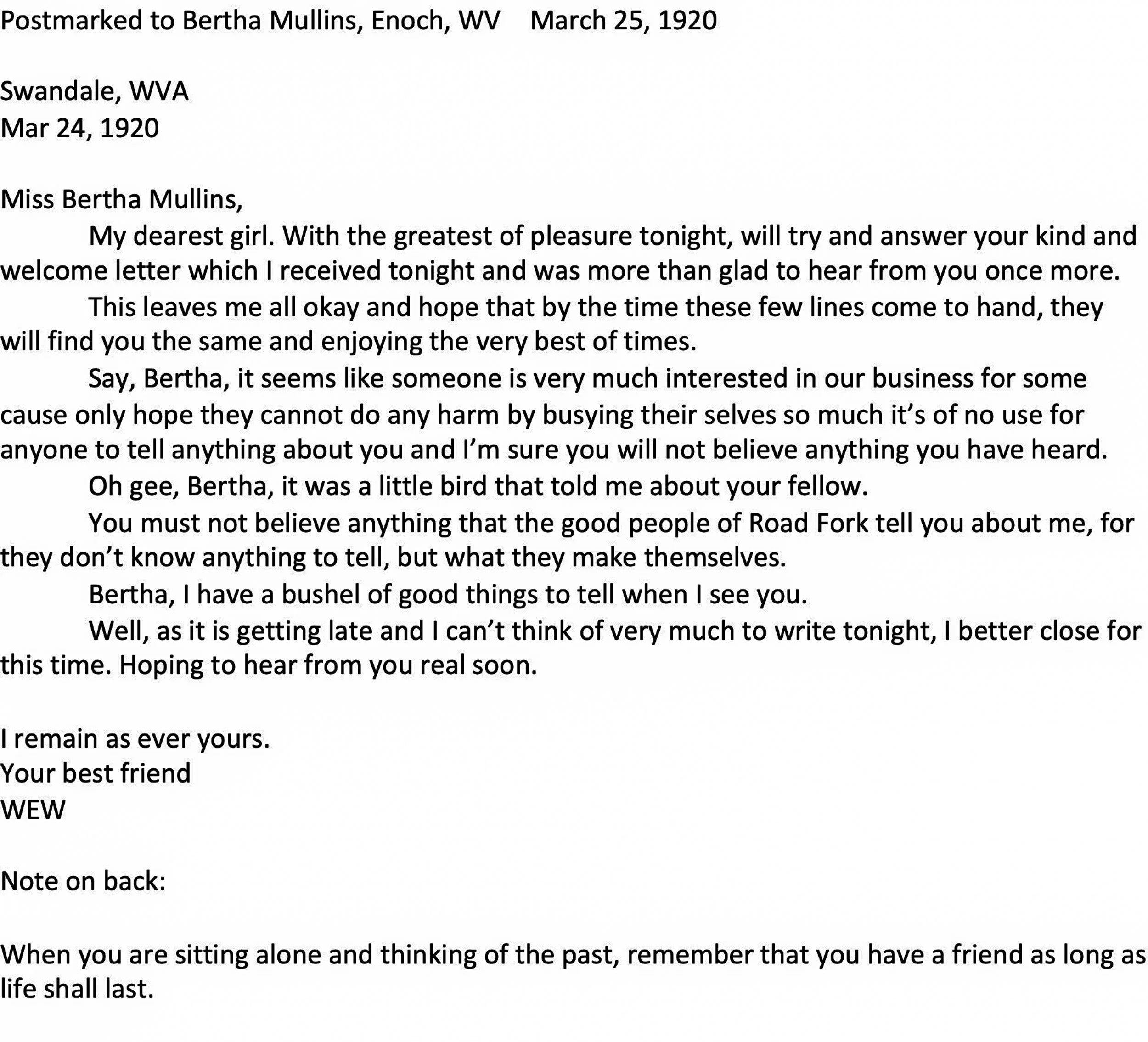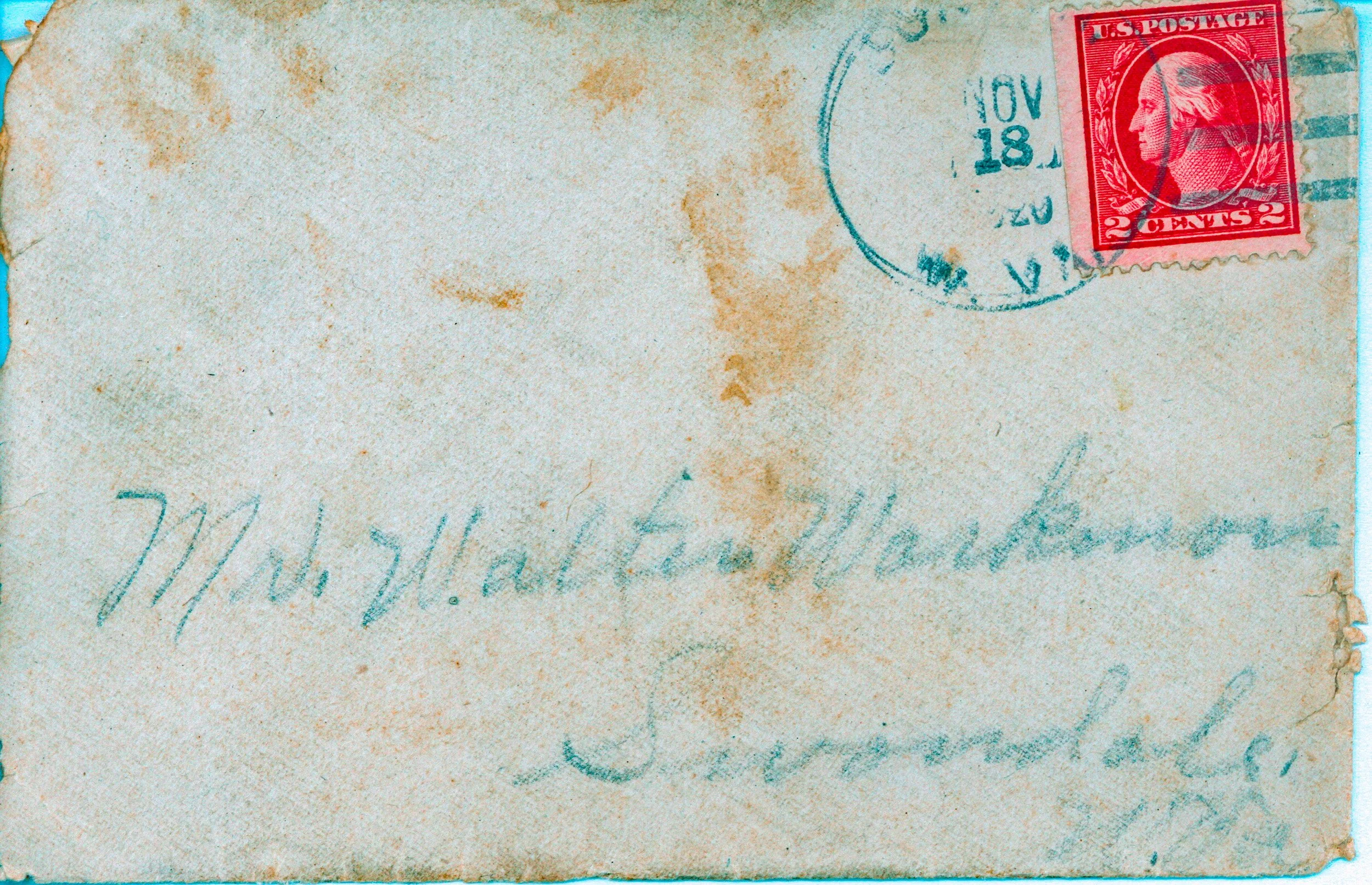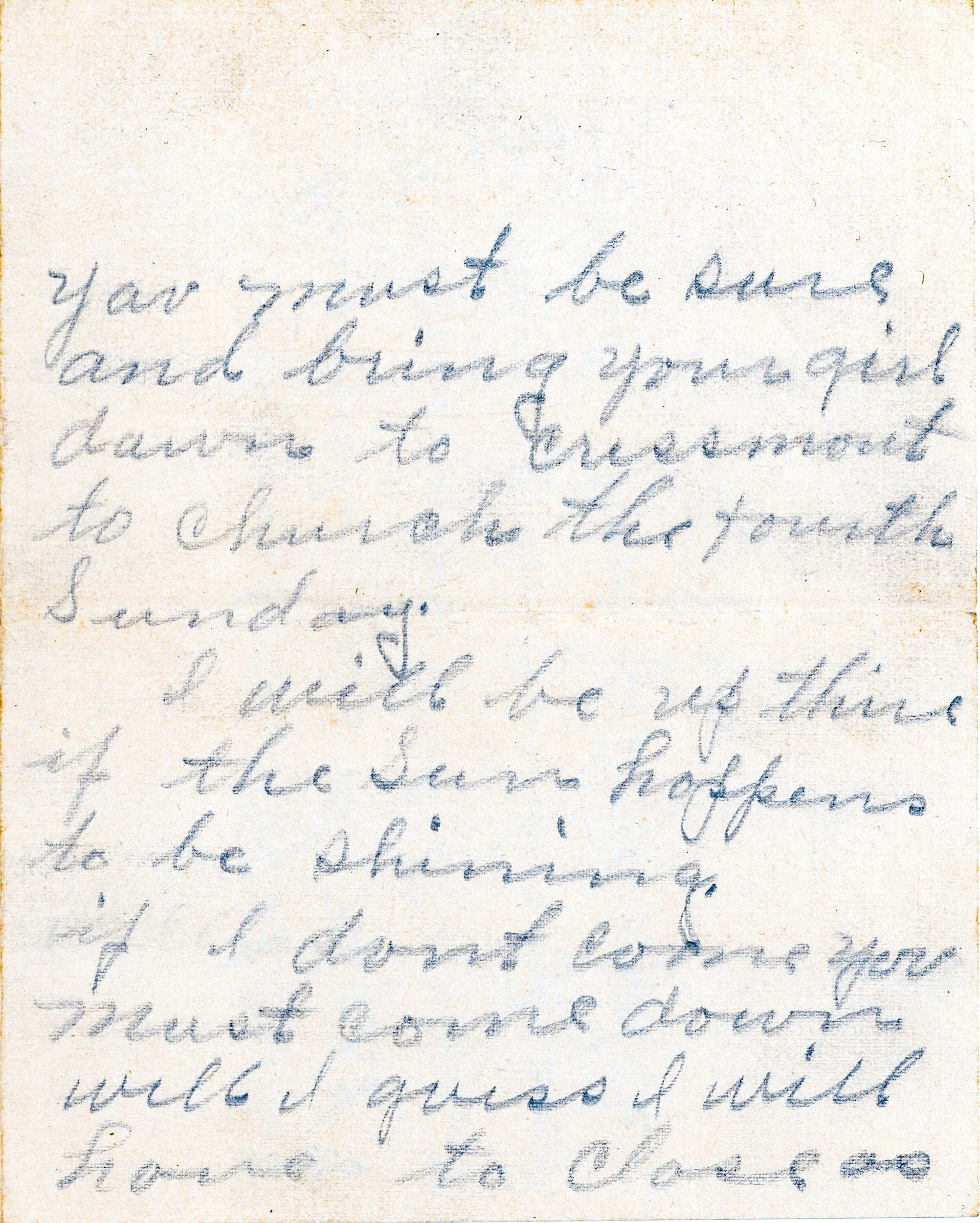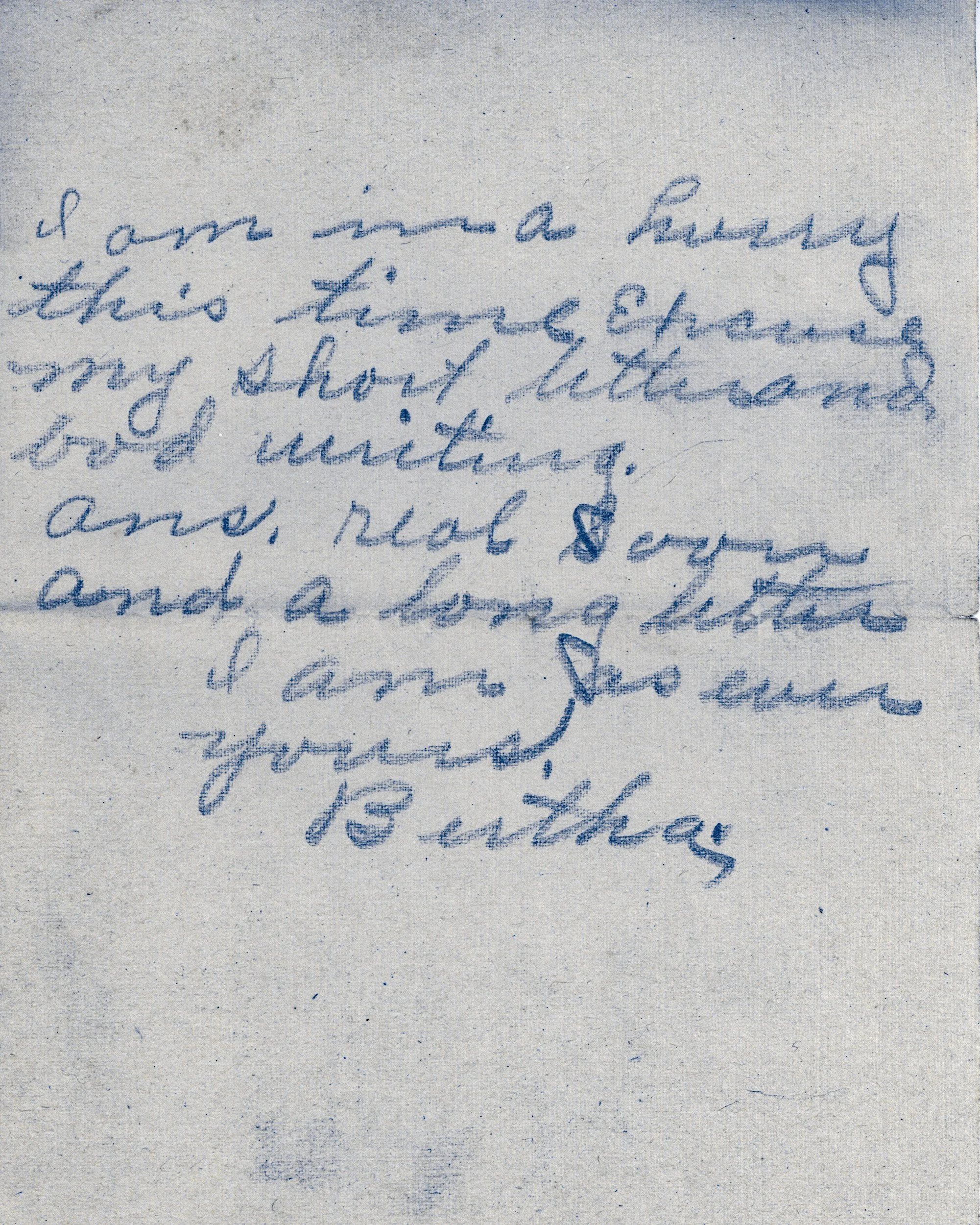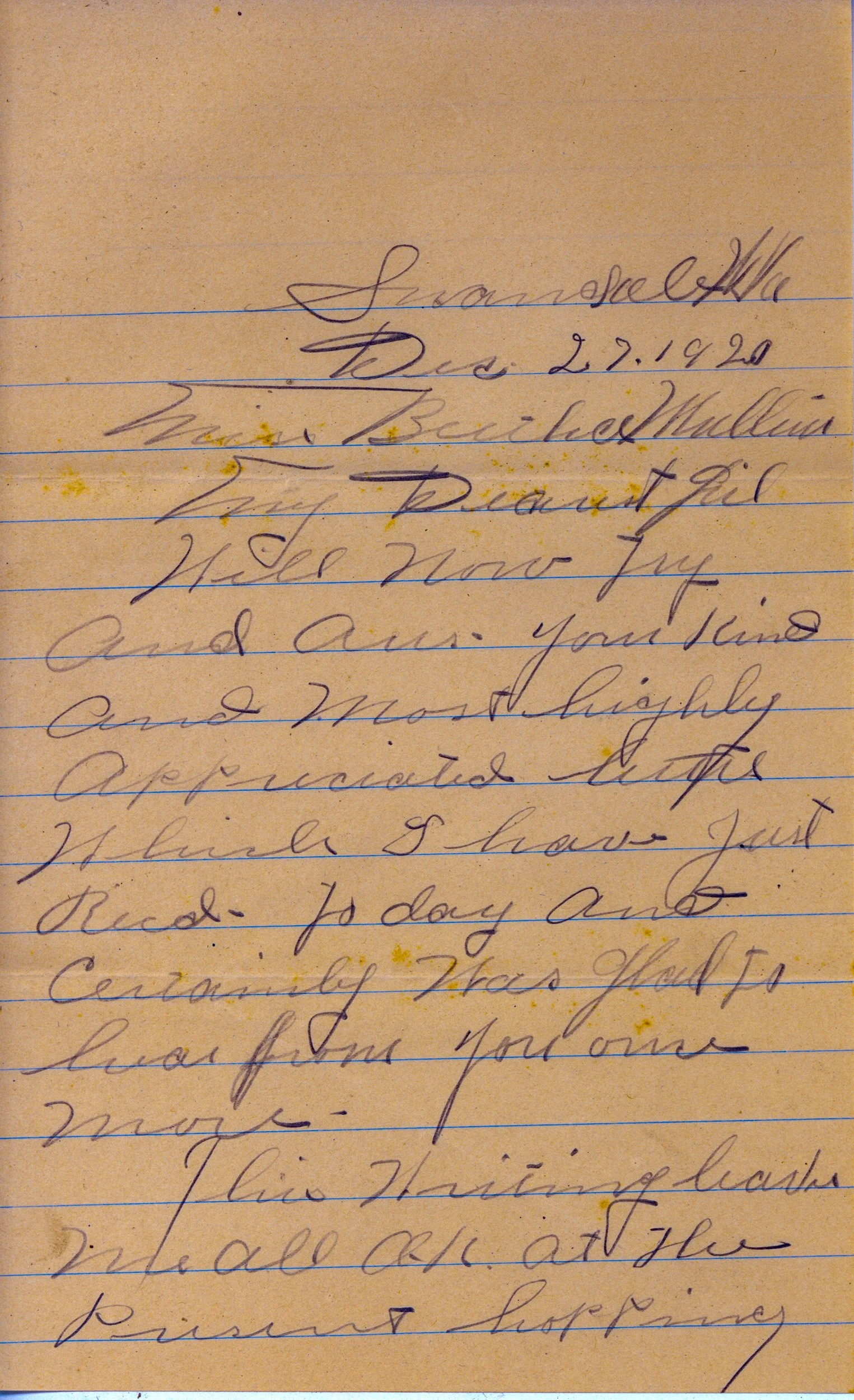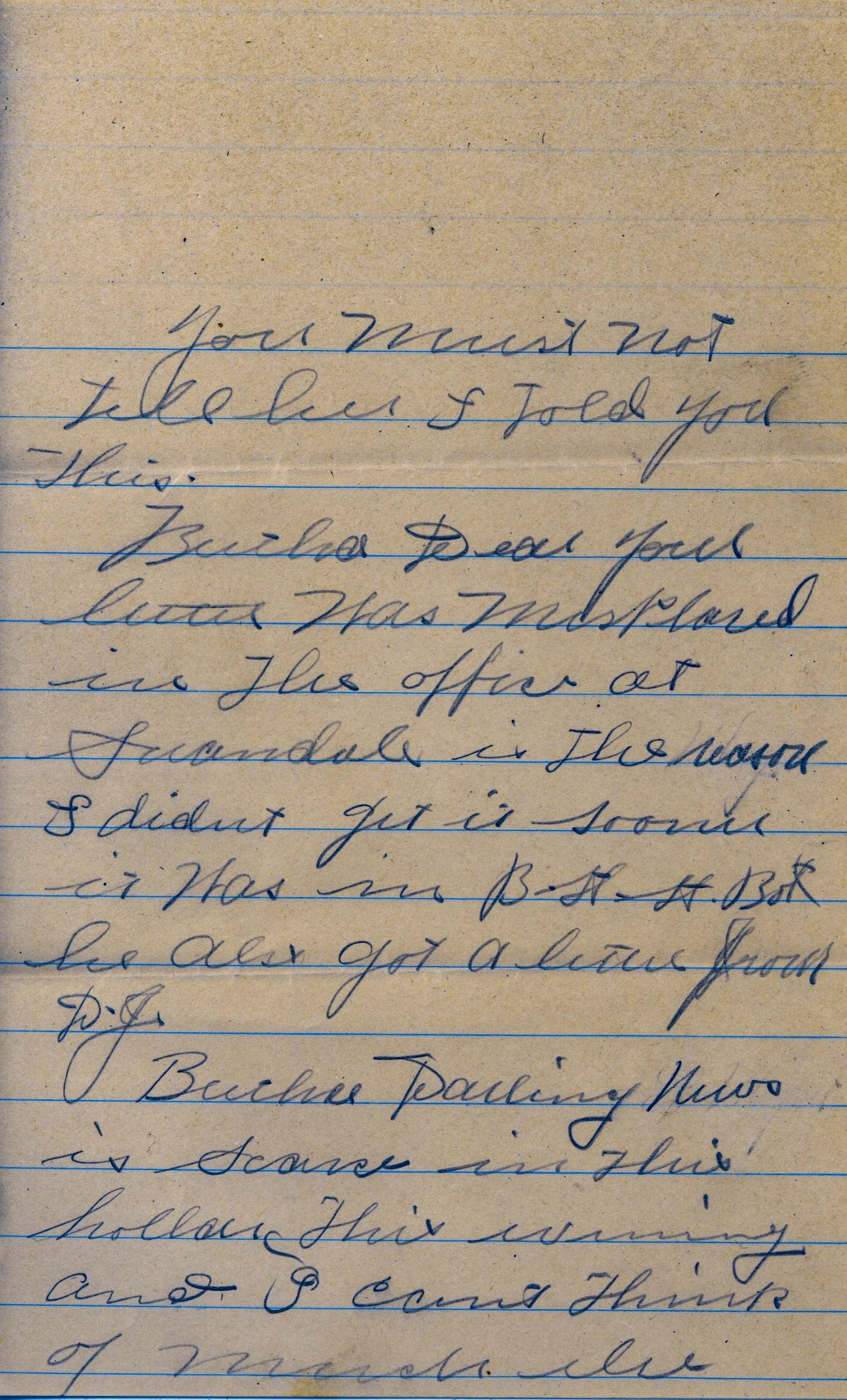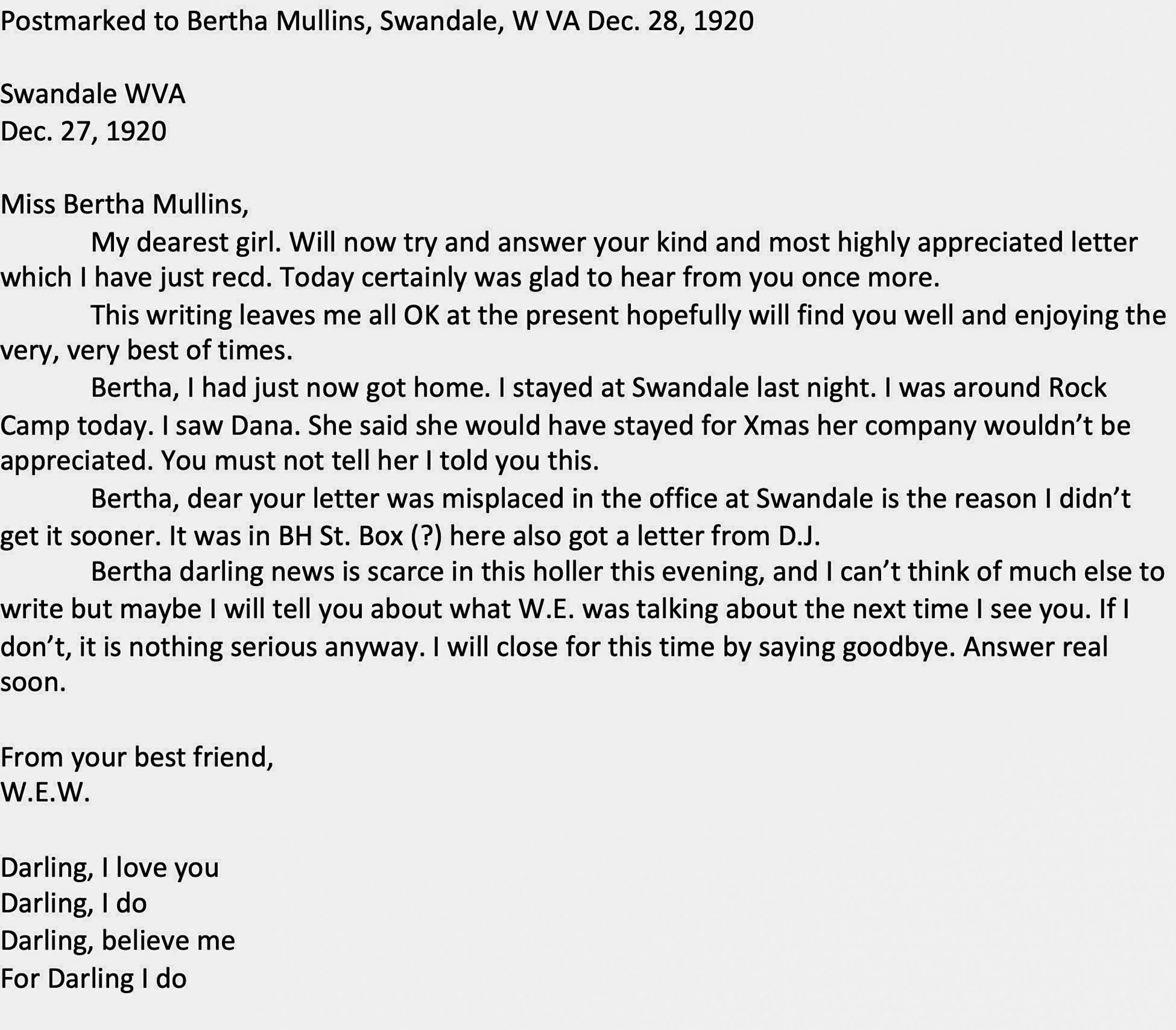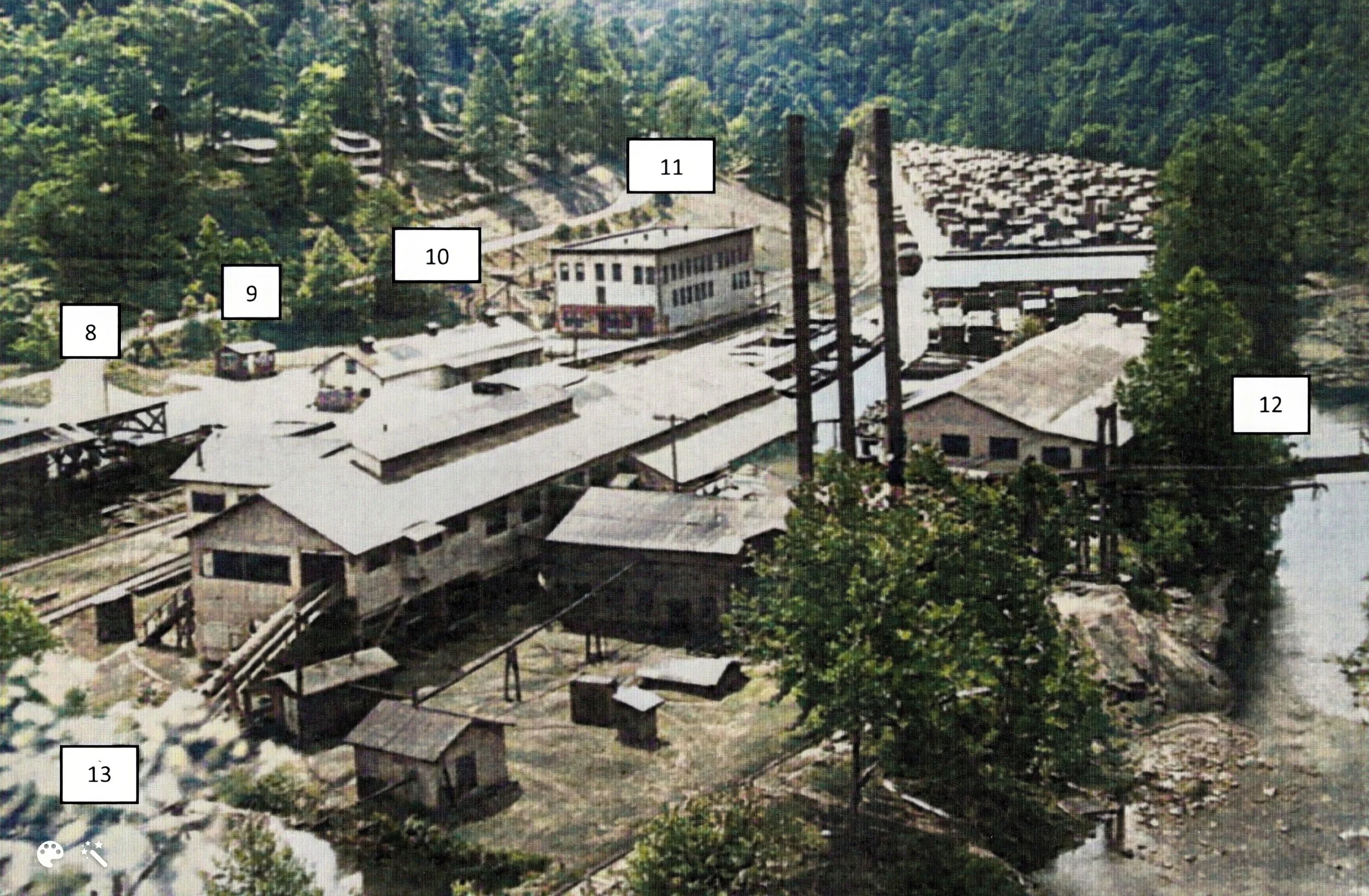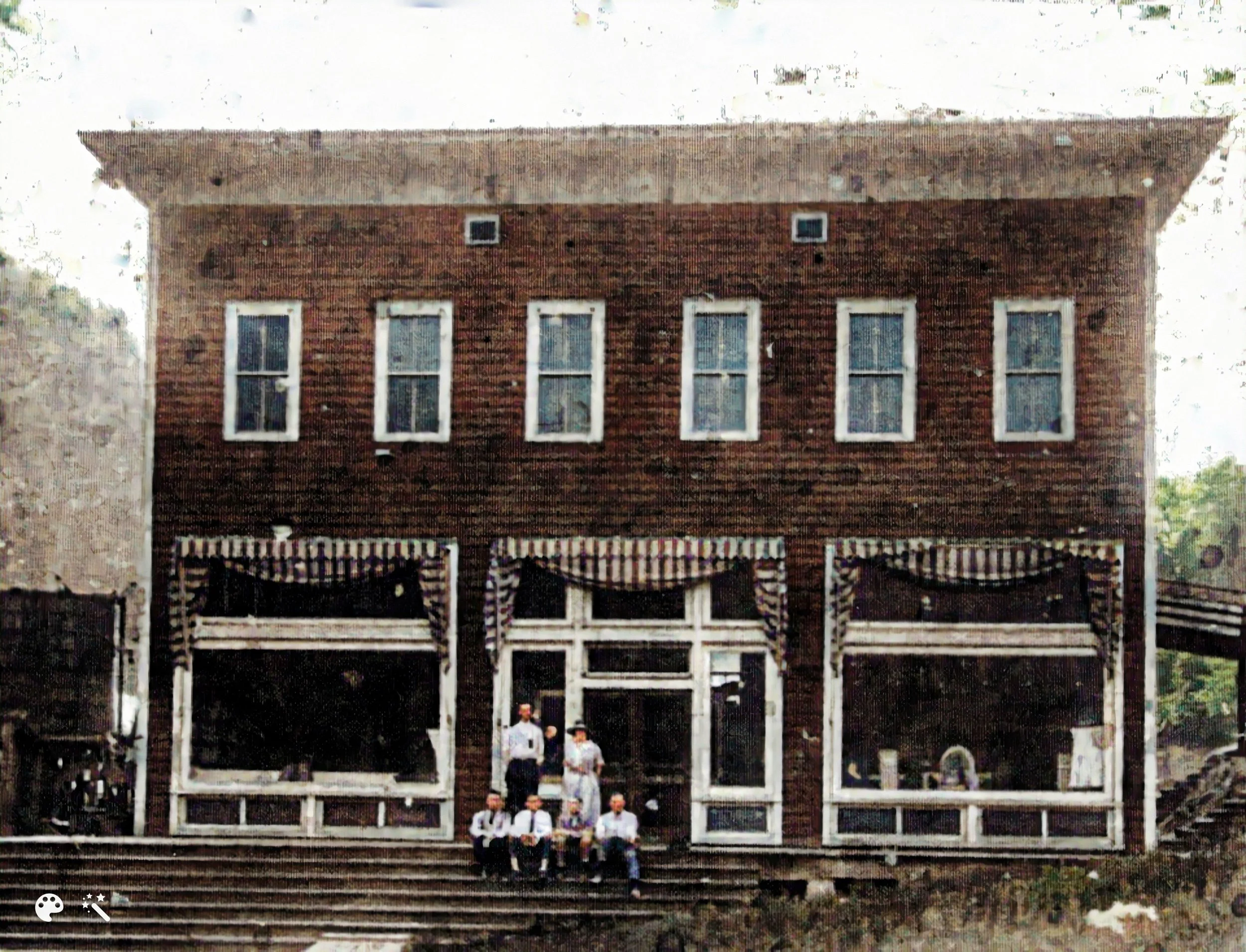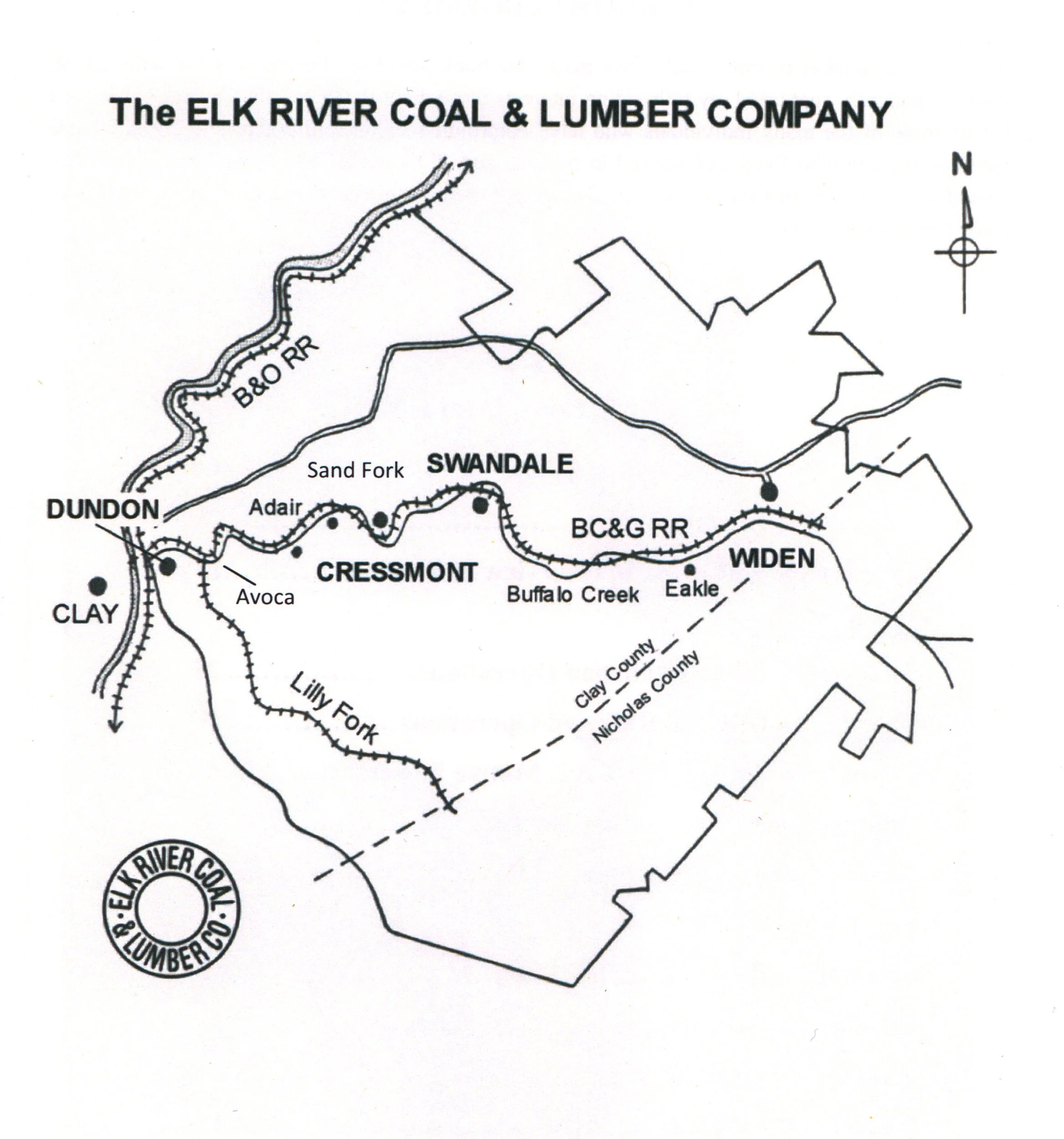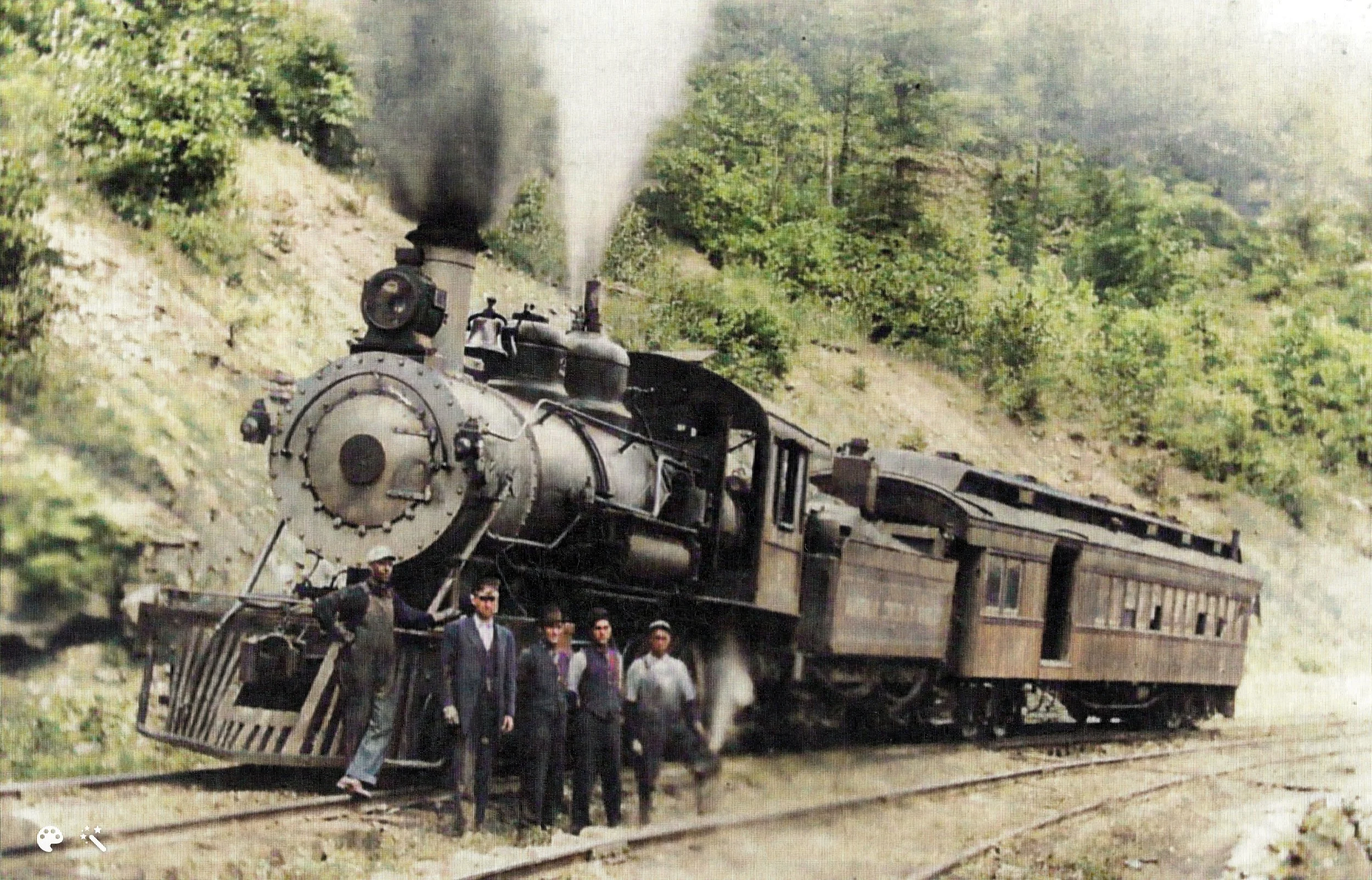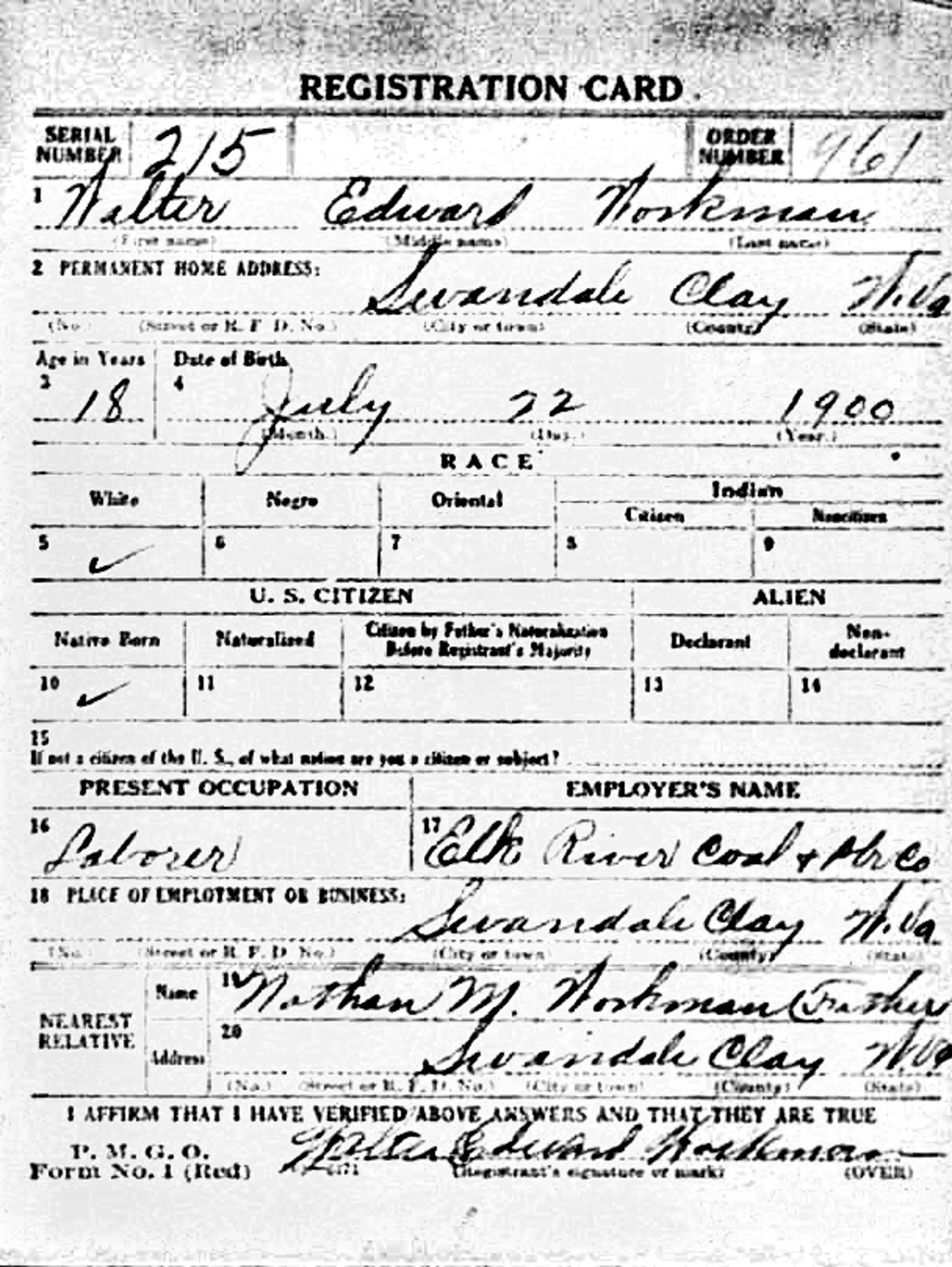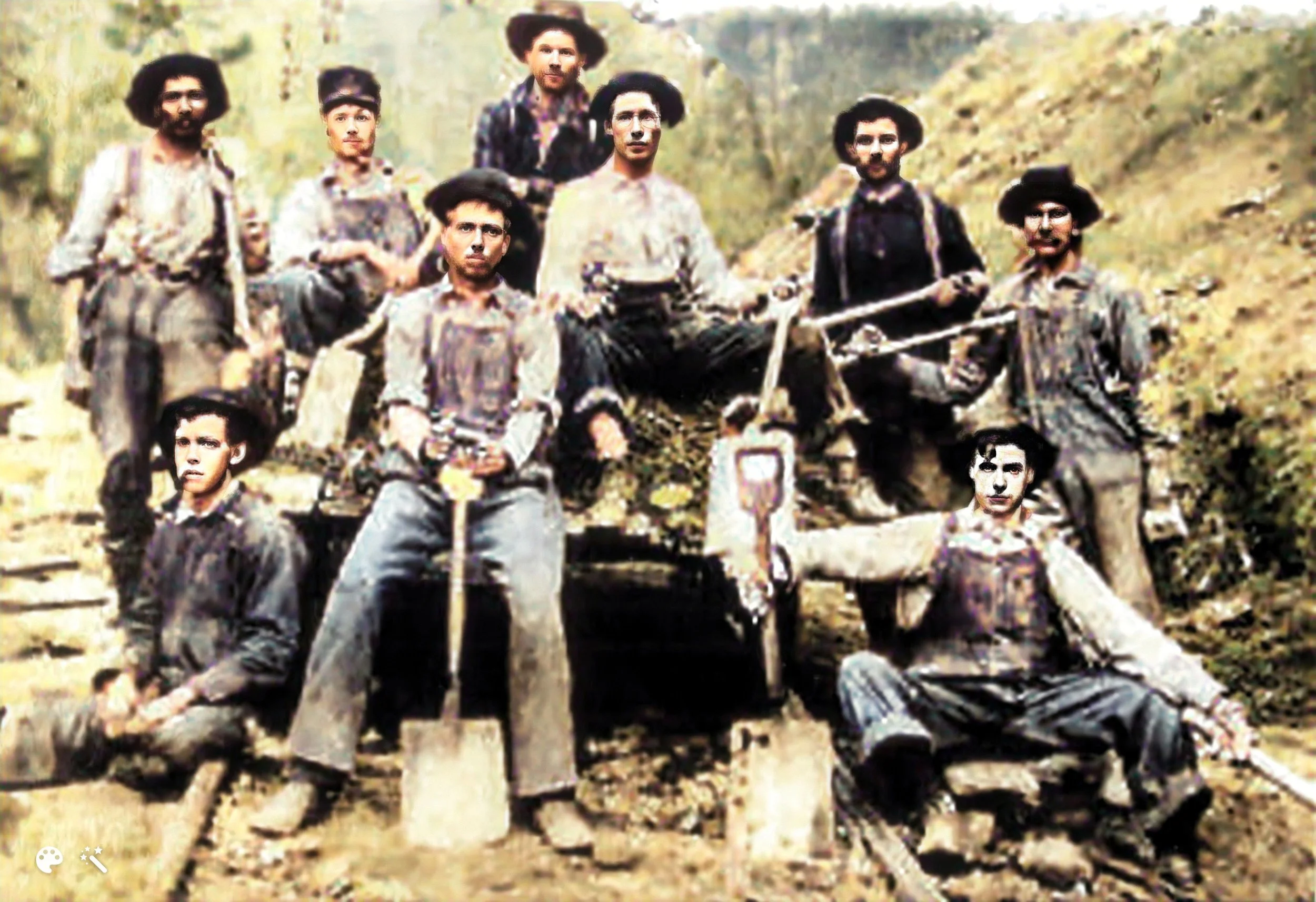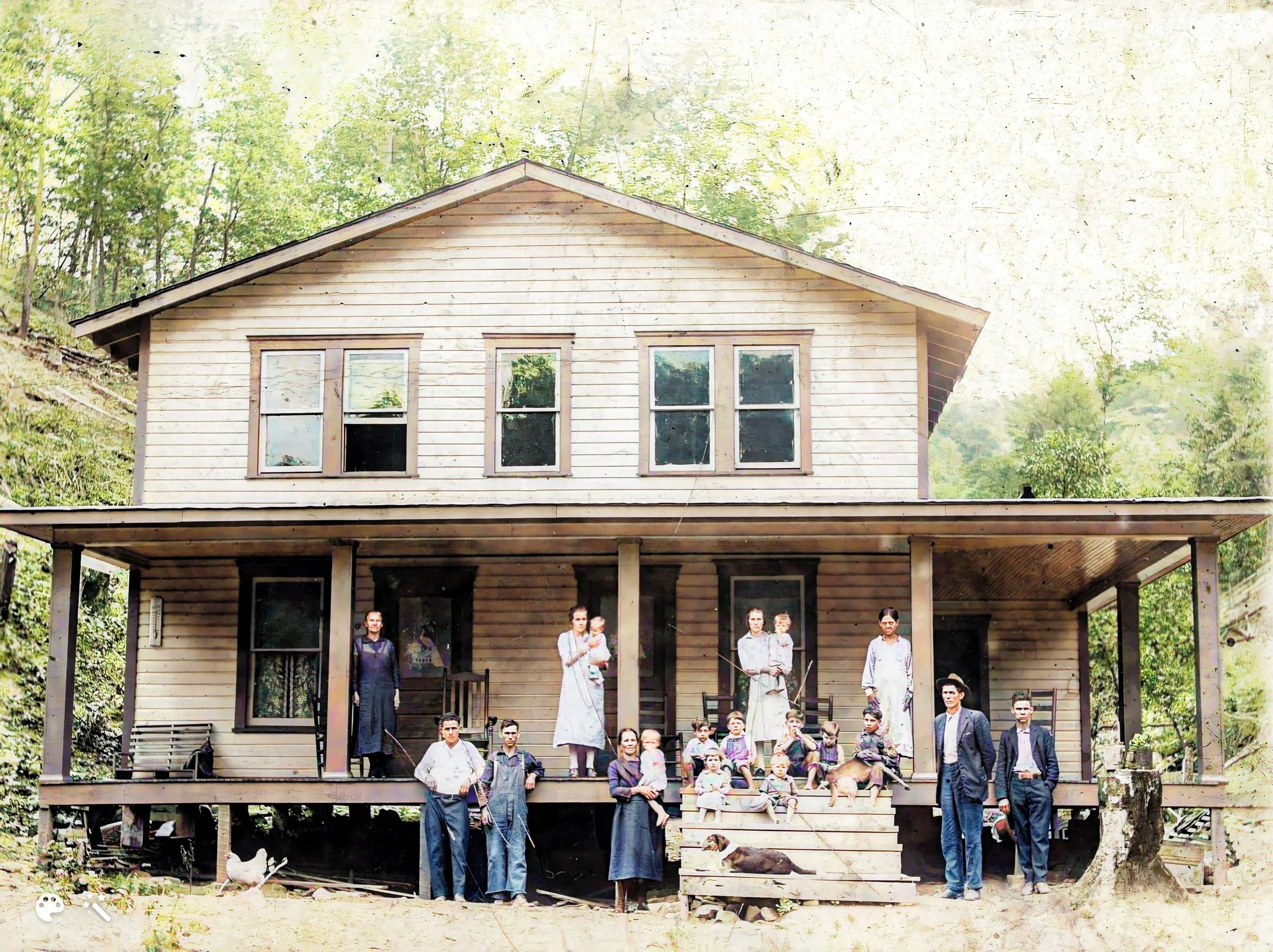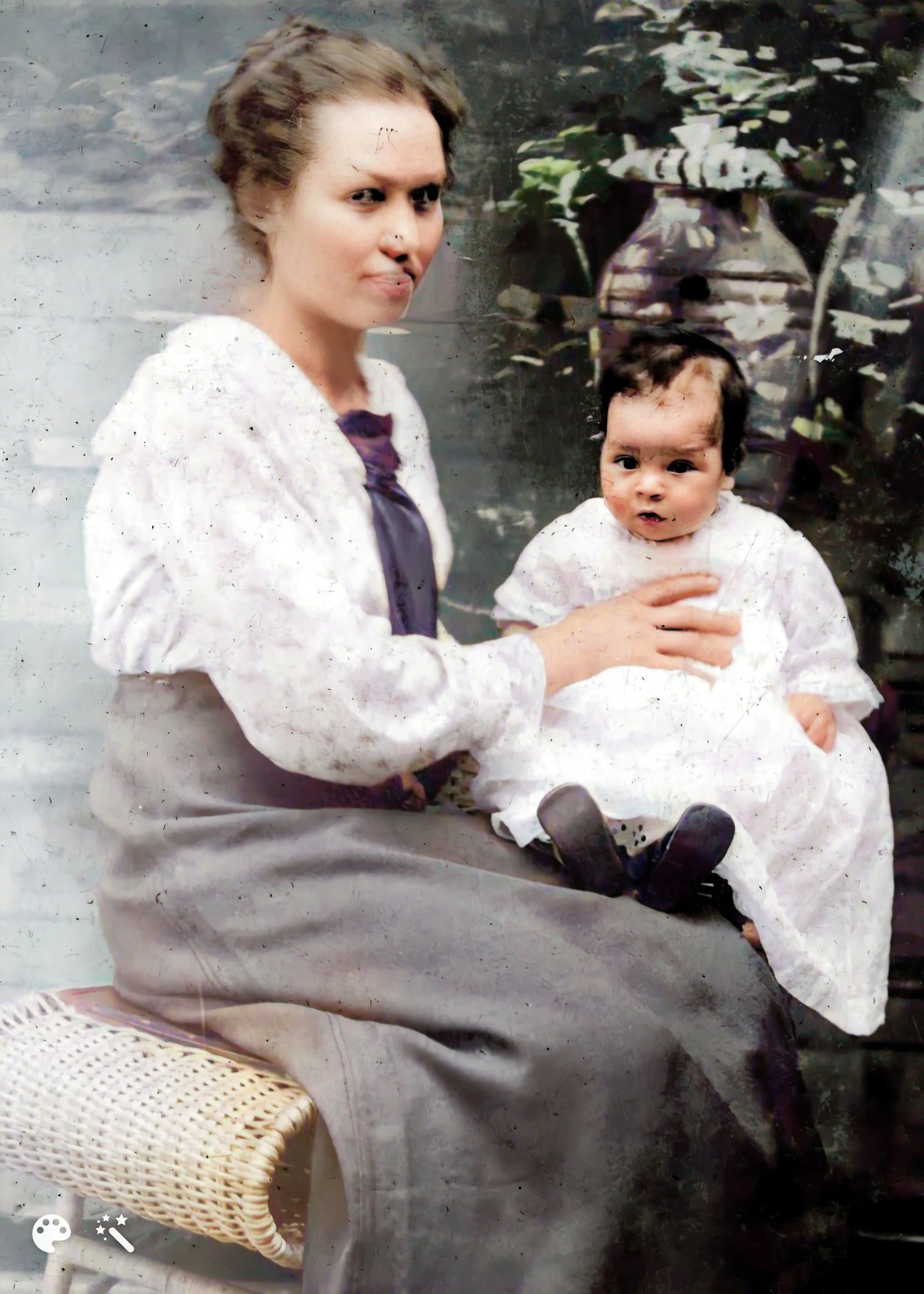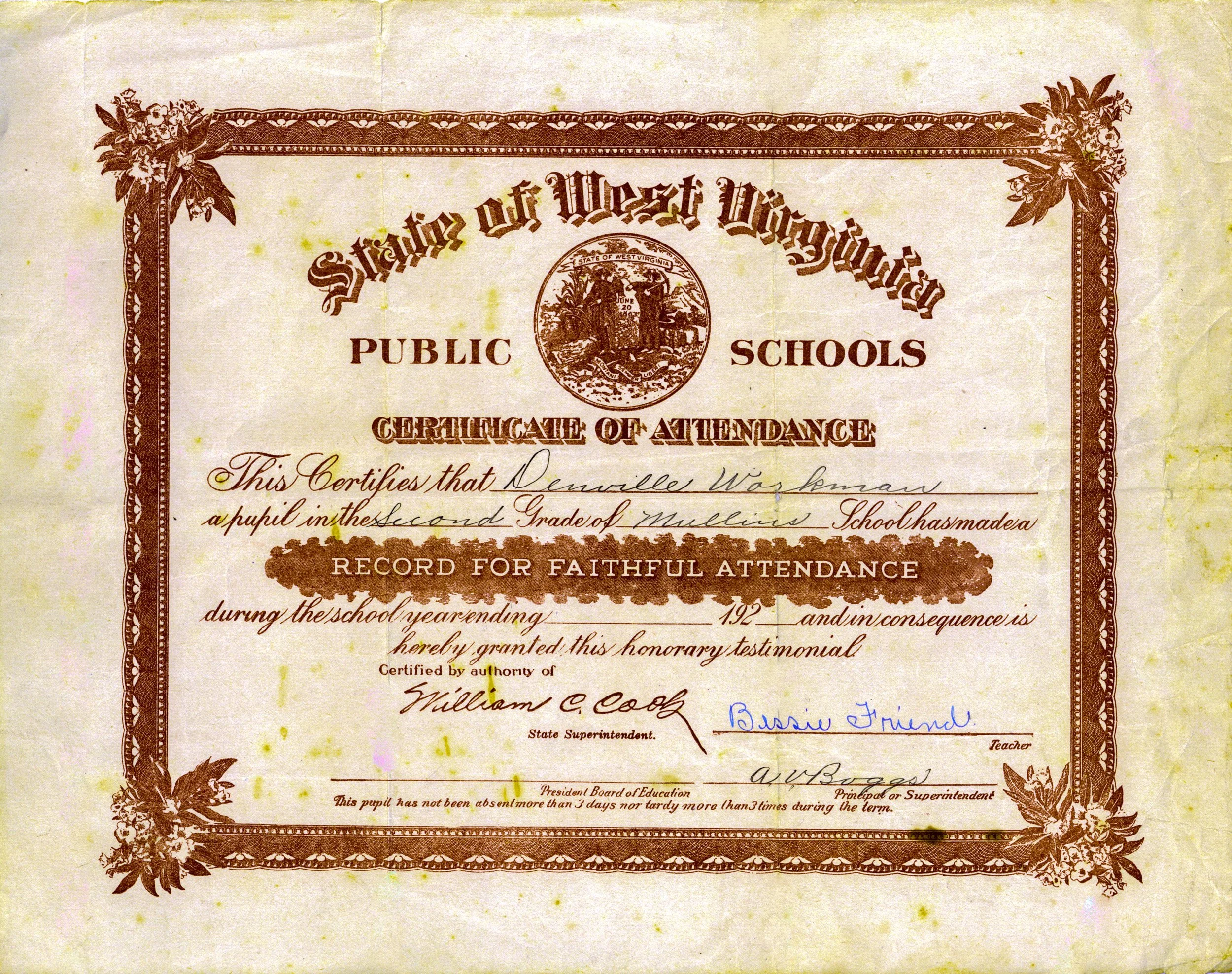Walter Edward Workman & Bertha Etta Mullins, 1920-1930 (The Early Years)
Walter & Bertha Workman-circa 1921
Walter’s & Bertha’s Ancestors
The “bowtie” chart below is an abridged version of Walter and Bertha’s family tree. It is included here primarily for visual interest. In-depth genealogical charts of the Workman and Mullins families will be available on this website soon.
Walter & Bertha’s Courtship & Marriage
I am unsure about when and where Granny and Grandpa met. The Workman family lived in the Enoch area, while the Mullins family lived in Maysel, just west of Clay.
We do have some of the correspondence between the two of them, dated beginning in early 1920. These are mostly letters from Walter to Bertha, but there are a few from Bertha to Walter. I have included scans of three of them for your enjoyment (see Gallery directly below). By the way, have fun trying to decipher their handwriting. A transcription is included for each letter.
I found these letters to be informative and interesting, telling me a lot about them as individuals and about the area/culture of that time. Here are a few of my observations about these “love letters”:
• Stamps were $0.01 for postcards and $0.02 for letters. I remember that even in the late 1950’s, stamps were only 3 cents. That gives you an idea of the extensive inflation that has occurred over the years.
• Their letters were short and strait forward. Other than talking face-to-face, letters were the only way they could communicate. There were no telephones at that time.
• I am inserting a couple of photos from that timeframe. Very few of the old photos had dates (or even names) written on them, so there is a good measure of guesswork involved in determining the year they were taken. [If you have better information, please let me know.]
• I surmise that Bertha was living in Clay or Dundon in 1920. Perhaps she was living there (alone or with family or friend?) to be closer to Walter, since Albert and Roxie lived in Maysel. Or maybe she had already moved out on her own. (The Dundon interchange is where trains were accessed.)
A few of the letters from Walter to Bertha were addressed to her in Enoch. I don’t think she ever permanently lived there, but perhaps she visited or stayed with family. At that time in history, postmasters knew many people all over the area so they would redirect mail to the correct location.
Dundon Interchange
This 1950’s photo shows the major elements of the interchange. The B&O station is in the foreground, with the B&O mainline running in front of the station and curving across the truss bridge to Charleston. The BC&G main (with hoppers setting on it) goes in front of the Dundon company store.
Housing was provided for employees. In the photo above, houses would have been just out of view, to the right of the trestle.
Photo from R. Brooks Stover’s book: The ELK RIVER COAL & LUMBER Company
• The postmarks indicate that Walter was living in Swandale in 1920. This corresponds with his employment information (see section below). Other places mentioned in the letters include Rock Camp, Road Fork, Robinson, and Cressmont. (I don’t know where Rock Camp and Road Fork were located.)
Swandale Sawmill
This view of Swandale (looking toward the west) is taken in the opposite direction of the adjacent photo of the town. It was taken in the mid-1950’s. A major effort had been undertaken to clean up the area around the sawmill. Visible in this photo are the engine house for logging engines [8], the post office [9], and the feed storage building [10] behind the company store [11]. The mill power house had three stacks by this time. The conveyor [12] reaching across the Buffalo Creek fed sawdust and waste wood to a fire that burned continuously. The mill pond [13] is hidden behind the trees.
Photos from R. Brooks Stover’s book: The ELK RIVER COAL & LUMBER Company
Swandale Town Layout
In this 1930’s photo of Swandale, the sawmill [1] is in the upper left corner. The enormous piles of drying lumber stretched along the track [2]. Across the track from the mill was the company store, a large 2-story frame building [3]. In this photo, it appears dark, probably “ERC&L red.” In subsequent years, it was light grey with green trim. The home of the mill superintendent is on the hillside [4]. The community building is in the foreground [5] and employee houses line the hillside [6]. Steam (used in the sawmill operation) was distributed to the houses via an asbestos covered pipe [7]. The population of Swandale around this time was about 200.
Photos from R. Brooks Stover’s book: The ELK RIVER COAL & LUMBER Company
• Walter alludes to getting groceries at Rhodes Store (in Swandale). This was actually the ERC&L company store; Jay Rhodes was the manager. This photo was taken in the 1920’s. The water tank that serviced the trains is just visible to the left of the store. The sawmill is hidden from view, behind the water tank.
The ERC&L Swandale Company Store
Photo from R. Brooks Stover’s book: The ELK RIVER COAL & LUMBER Company
• A lot of the words/phrases were colloquialisms, repeated in each letter. For example, this the opening paragraph of a letter dated March 3, 1920:
“My dearest girl. It gives me great pleasure tonight to answer your kind and loving letter which I recd [sic] last night and was glad to hear from you. This leaves me all OK and hope these few lines will find you well and enjoying life just fine….”
• They make frequent reference to meeting at church. That is not surprising, since the church was usually the center of community activities at that time in history. People took their relationship with God seriously. A couple of the letters mention a church at Cressmont (he encouraged Bertha to be sure to come to the eleven o’clock service). I could not find any additional information about that church.
• The distance between Swandale and Dundon is approximately 8 miles. There were no roads along the Buffalo Creek directly connecting the two towns; besides, neither Walter or Bertha had a vehicle. Walter mentions multiple times in his letters that travel occurred via the railroad. That would be the Buffalo Creek & Gauley line. The 1920 schedule shown here allowed ample opportunity to go either direction and back, in the same day. The trains primarily hauled coal and lumber, but there were passenger cars available as well, as shown in the photo.
The railroad was a key part of life during the first half of the 20th century; subsequently, further examination is warranted. For more information about the BC&G Railroad, and the ERC&L Company in general, see the Bentree & Beyond menu.
Photos from R. Brooks Stover’s book: The ELK RIVER COAL & LUMBER Company
• The tone of the letters started out “friendly”, but in less than a year, they were openly expressing their love for one another. They were married March 16, 1921, at Albert & Roxie’s home in Maysel.
Walter & Bertha—Multiple Occupations and Multiple Residences
The earliest employment record for Walter that I have found is his Selective Service registration for the WWI draft (required when he turned 18). In that document, his occupation is listed as laborer for Elk River Coal & Lumber Company, in Swandale.
Elk River Coal & Lumber Company
This map shows the 100,000-acre holdings of the Elk River Coal & Lumber Company (irregular outline) in Clay County. Also shown is the 18.6-mile-long Buffalo Creek & Gauley Railroad (BC&G) that ran along its namesake, Buffalo Creek. The BC&G connected with the Baltimore & Ohio Railroad at Dundon. The railroad terminated at Widen at the east end. Between Dundon and Widen, the railroad served Cressmont and Swandale. In the late 1950’s, the ERC&L logging operations were conducted on the 9-mile long spur along Lilly Fork. The Lilly Fork joined the BC&G at Avoca. This map was drawn by R. Brooks Stover (published in his book: The ELK RIVER COAL & LUMBER Company). It is based on a map that appeared regularly in the Widen News, a publication of the ERC&L, in the 1950’s. See Resources Directory & Bibliography tab in the menu bar above for details.
Based on Hollie’s autobiography, we know that their father, Nathan Melvrie Workman, also worked for ERC&L as a track maintenance worker. For more information about this company, see Bentree & Beyond.
I noticed that most of these men had names found in our family tree (Hamrick, McKinney, and Ramsey). Further investigation reveals the following: Abner and Ben Hamrick were Juditha’s brothers; Onnica O’Brien was a son-in-law. Nathan McKinney was a brother to Isabelle McKinney. Sidney Ramsey was a first cousin to Juditha.
A typical work crew in Swandale. This one included my great grandfather, Nathan Melvrie Workman.
Left to right, sitting: Ben Hamrick, Nathan Melvrie Workman, Braden Blankenship, Roy Young
Left to right standing: Nathan McKinney, Abner Hamrick, George Hamrick, Sidney Ramsey
Photo from Joy Buck, West Virginia History & Culture
ERC&L Work Crew, Swandale
According to Uncle Damon, Walter and Bertha lived in the Swandale area when they were first married. Walter worked at the Mullins sawmill there, for “a while”. (This was after his short stint with ERC&L Co.) Albert apparently had at least two sawmills operating concurrently—in Swandale and Maysel areas. Walter moved to the Maysel area to work at Albert’s sawmill there (circa 1923). I have included a couple of photos of Albert’s operations for reference. (I am not sure of the actual dates these photos were taken or the locations, but they will give you an idea of the setups.) Additional information about Albert’s mills is included under the Bentree & Beyond.
Left to right: Andy Adkins (beside horse), Albert Mullins, Clarence Bragg, Pat Mullins (Albert’s son), Sherman Mullins (Albert’s brother)
Walter was just one of the workers—he worked awhile and was unemployed awhile. It is possible they lived in the housing provided for sawmill employees, or they might have lived with Albert and Roxie. Albert had a large house. Based on this photo, it was apparently the gathering place for the Mullins family. By the way, it has been said that Walter was the primary builder of that house (see photo below). So, you can add carpenter to his resume.
Albert & Roxie Mullins home in Maysel
circa 1927
Bertha was apparently a (part-time?) bookkeeper for Albert during this timeframe. It is unknown who initiated it, but in the late 1920’s, they opened the Mullins & Workman Hardware store in Clay. The name was apparently later changed to Workman Lumber & Hardware. As described in one of Damon’s stories, the enterprise didn’t last long. The excerpted transcription is presented below. To hear Damon’s actual audio clip, see Resources Menu above.
[DEWv1: Walter & Bertha operate hardware store in Clay (Pisgah) (09:00-10:46)]
Damon: See, when that depression hit back in the 30's ('32 probably when it got bad), Daddy and Mom run a little store down in "Piskee" [Pisgah]. I've got some labels here. Workman…what was it called, Workman Lumber and Hardware, I believe it was called.
Mike: Where was it?
Damon: Over at Clay, across the [Elk} river, in what was called Piskee. I've heard them talk about it, of course, that was before I was ever born. Daddy made window facings and door facings. Sold roofing and stuff of that nature, you know. Kind of like, people didn't buy all that stuff put together back then. But when that depression hit, he had bought goods from the wholesale places in Charleston and then credited it out. Well, people when they lost their jobs, they quit paying. So, he couldn't pay for his--they just foreclosed, what they call foreclosing on him. They just come up and took everything they had. I've heard my mother tell it, they just come there and set kegs of nails and windows and whatever it was in the store, they set it out on street and sold it for whatever they could get out it. Then they owed the rest. So, they had to just move out.
So, when the Great Depression hit, they went under. That’s when they moved to the farm on Buffalo Creek. There is more information on that in the next section.
The Nathan Workman family lived primarily in eastern Clay County. According to Hollie, they moved around a lot, but generally within a ten-mile radius centered around Robinson Fork of Buffalo and its surrounding hills and tributaries.
Walter & Bertha’s Timeline
It was during this decade that Denvil, Phyllis, Freda, and Damon were born. This timeline summarizes the events of this epoch and puts them into context of Walter and Bertha’s entire lives.
Be Fruitful and Multiply!
Even with the benefit of birth certificates, it is difficult to pinpoint exactly where W&B’s progeny were born.
• According to his birth certificate, Denvil was born in Henry District, Clay County (January 19, 1922). As you can see from this 1873 map, Henry district encompassed almost a third of the county and included the town of Clay. [By the way, the districts in Clay County were consolidated from five to three in the 1970’s.]
I don’t know for sure, but my best guess is that Dad was born in Maysel (most likely in Albert’s home). Another fact supporting this theory is that the attending doctor was A. R. Brown from Clay. It is only a four-mile trip from Clay to Maysel, one easily made by car or even horse-drawn wagon.
***************************
In my father’s birth certificate, his name is listed as Denville Jeffery. Throughout his adult life, Dad (and everyone else) wrote his name as Denvil Jefferson. I can think of a couple of explanations for the disparity:
• Apparently, the name Denville was commonly used in that era. Actually, I am not sure how common it was, but I have found two other men, associated with our family, who had the name Denville. Walter and Bertha may have liked the name and subsequently adopted that spelling. At some point (maybe in elementary school) they/he decided to spell it as “Denvil”. All of the records for high school and later show “Denvil Jefferson”.
• A second explanation would a transcription error on the part of the person(s) who recorded the birth certificate. I can envision the information being recorded and sent to the state without Walter and Bertha ever seeing the actual document. In fact, the birth certificate was obtained 20 years later, so they probably never viewed the certificate until 1942.
These two explanations would apply to his middle name as well. There may be other reasons for the name difference. In the end, it is apparent that Dad’s desired name was “Denvil Jefferson Workman”.
Bertha & Denvil Workman-1922
Denvil Workman-circa 1923
Phyllis & Denvil Workman-circa 1925
Denvil Workman-circa 1928
• Phyllis Irene was born in Robinson, Clay County (October 7, 1923). At that time, Walter and Bertha were living in Swandale, which is closer to Robinson than to Maysel. My supposition is that Granny went to Nathan & Juditha’s home to deliver the baby.
Phyllis Workman-circa 1929
• Freda Maxine was born somewhere in Clay County (March 14, 1925). I think Walter and Bertha were still living in Swandale at that time, so Freda could have been born at home.
Freda Workman-circa 1929
• Walter and Bertha had a stillborn daughter (May 5, 1927). Although they did not choose a name for her, the grave marker bears testimony to their loss. The information I have gathered places the location of the grave site in the Ramsey Cemetery.
• Damon Edward was born in Maysel (July 13, 1928). Based on what I can piece together, Walter and Bertha moved back to Maysel in mid-1926. Damon was probably born at home (or perhaps at Albert & Roxie’s home).
• Dale Brenford was born in Adair (September 21, 1930). So, that would have been shortly after they moved to the Buffalo Creek farm. He would have been born at home.
School Days
The first record I have found of schools is the “Certificate of Attendance” for Denvil, shown here. He attended Mullins School, which was an official West Virginia public school. So far, I have not found any additional information about it; however, I do have some theories:
• Denvil would have been about seven years old in the second grade, so they would have still lived in the Maysel area at that time.
• I don’t believe it was coincidental that the school was name Mullins School. Albert Mullins had an ongoing involvement with public schools. He was on the Clay County school board and later built the Ida Grade School in Bentree.
• It seems reasonable to me to conclude that this Mullins School was conceived and perhaps funded by Albert to provide educational opportunities for his grandchildren and the general public. So, my guess is that it was a one-room building somewhere near his home in Maysel.
Denvil and Phyllis (but probably not Freda) would have attended this school until the family moved to Buffalo Creek.

